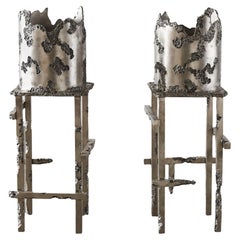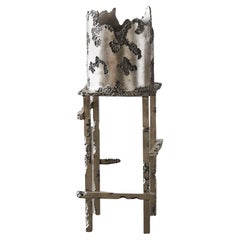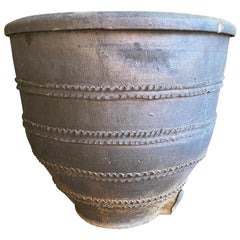Australian Planters, Cachepots and Jardinières
3
2
to
5
2
2
3
1
2
3
2
1
1
Height
to
Width
to
3
3
2
2
1
2,832
2,481
816
543
507
3
Place of Origin: Australian
Pair Rare John Campbell Terracotta Chinoiserie Planters or Umbrella Stands
Located in Melbourne, AU
An exceptionally rare pair of John Campbell planter pots. The design is attributed to John Cambell's son, Rupert John Campbell.
John Campbell produced decorative pots at his brick works and pottery in Launceston, Tasmania from 1880 until 1975. Rupert John inherited his father's works and was a skilled artisan and potter. He developed presses for decorative pottery.
This beautiful pair of jardinières likely date to the early 1900s. They were passed down through three generations. The original owner gave them to her son. In the 1980s the (then elderly) son gifted them to a friend (the last owner before this sale). At the time they received them they were made aware of their age and rarity. Now, another forty years later, they are potentially the only pair in existence.
Only one similar John Campbell un-glazed terracotta 'umbrella stand' can be found on record. It was sold in 2008 in Tasmania, at a 'Fine Colonial Decorative Arts' auction run by Mossgreen Auctions, a reputable auction house, though since closed. I can find no other reference to this model, except an acknowledgement of the existence of an un-glazed terracotta umbrella stand, in the definitive record of Campbell's work by Kevin Power, 'John Campbell Pottery: Recollections and Collections' published 2014.
These are of the same design and size but were manufactured with drainage holes in the base. They were clearly decorated using a press but the clay slabs were pushed into the press by hand. The interior of each pot shows the marks of hammers used to force the clay into the face of the press pattern. They have a hand-crafted appearance, with hand finished mould lines to each side and there are pressing faults apparent in various areas of the pattern.
Tasmania was notably independent in production of most household goods, due to the isolation of the colony right up until the turn of the 19th century. Being at the farthest reaches of the British Empire, settled as a penal colony, with a relatively low consumer population, it was not a market for the high-volume import of domestic goods.
As a consequence, household wares and decorative pieces produced in Tasmania through the 19th century represent a wholly independent category of Australian colonial design, production and craft. These pots are highly collectable and scarce artifacts of one of Tasmania’s earliest industries.
In aesthetic terms, many Tasmanian artifacts are notable for following British, Georgian and Victorian fashions but with a colonial character of their own devising. Local characteristics became a stronger feature of Tasmanian decoration over time. Note the classical Georgian/Victorian chinoiserie motif of a bird foraging among rushes. In this case, the local interpretation depicts a Brolga (the largest Australian wetland bird) foraging amongst native Australian reeds and water lilies.
Another of the things that sets early Tasmanian artifacts apart is the way in which necessity forced artistic production in pottery to be less refined than that of their British counterparts. A broad range of products had to be produced to meet local requirements, often by a single producer.
John Campbell’s pottery is a great example of this practical necessity. It produced everything from industrial drainage pipes and bricks to household pottery and decorative items, all from a relatively small family run factory. Their domestic wares were so well trusted and appreciated that they by the 1940s they made their way all over the mainland of Australia.
Under these circumstances, the refinement of decorative technique was not as great a priority as utility, consistent quality of production and durability. As a consequence, Australian colonial works and their early 20th century descendants such as these pots, are hugely appealing. They have an idiosyncratic and vernacular appearance, with British and European stylistic trends of their day overlaying a base of inventiveness, local interpretation and sturdy functionality.
We hope you can appreciate the rarity and significance of this well-preserved pair of planter...
Category
1930s Chinoiserie Vintage Australian Planters, Cachepots and Jardinières
Materials
Terracotta
Future Ruins Planter II by Michael Gittings
By Michael Gittings
Located in Geneve, CH
Future ruins planter II by Michael Gittings Studio
Dimensions: d 25 x w 25 x h 73 cm
Materials: stainless steel
Michael Gittings
Melbourne based des...
Category
2010s Modern Australian Planters, Cachepots and Jardinières
Materials
Stainless Steel
Set of 2 Future Ruins Planters by Michael Gittings
By Michael Gittings
Located in Geneve, CH
Set of 2 future ruins planters by Michael Gittings Studio
Dimensions: d 25 x w 25 x h 73 cm
Materials: stainless steel
Michael Gittings
Melbourne based designer Michael Gitting...
Category
2010s Modern Australian Planters, Cachepots and Jardinières
Materials
Stainless Steel
Future Ruins Planter I by Michael Gittings
By Michael Gittings
Located in Geneve, CH
Future Ruins planter I by Michael Gittings Studio
Dimensions: D 25 x W 25 x H 73 cm
Materials: stainless steel
Michael Gittings
Melbourne based desi...
Category
2010s Modern Australian Planters, Cachepots and Jardinières
Materials
Stainless Steel
Set of Ten Original Mid-Century Earthenware Terracotta Planter Pots, 1950s
Located in Melbourne, AU
Original midcentury earthenware terracotta pots, approximately 5.3 inches/13.5cm diameter and 5 inches/13cm high with lovely colour variations ...
Category
1950s Mid-Century Modern Vintage Australian Planters, Cachepots and Jardinières
Materials
Earthenware, Terracotta
Related Items
Spanish 18th Century Black Terracotta Urn, Planter
Located in Atlanta, GA
A rare and stunning black terracotta urn from the Girona area of Spain. Beautiful patina and condition. A wonderful piece for any interior of exte...
Category
Late 18th Century Antique Australian Planters, Cachepots and Jardinières
Materials
Terracotta
Italian Terracotta Planter
Located in New York, NY
Italian terracotta planter. Vintage acanthus leaf rectangular cachepot planter with great patina and scale. Italy, 1940’s. $950
Dimensions: 14.75"...
Category
1940s Vintage Australian Planters, Cachepots and Jardinières
Materials
Terracotta
1950s French Blue and White Floral Cast Iron Planter
Located in High Point, NC
A cast iron planter from France, circa 1950. Recalling the French countryside of a bygone era, cast iron elements are bolted together in a charming rustic construction. Adorned with ...
Category
1950s French Provincial Vintage Australian Planters, Cachepots and Jardinières
Materials
Iron
Vintage Wicker Garden or Porch Planter Stand
Located in Las Vegas, NV
Fabulous, 1930s, tightly woven wicker plant holder with spiral turned wood legs.
Painted motif of red and black in center. High skilled craftsmanship.
Galvanized inner liner.
Category
Early 20th Century Aesthetic Movement Australian Planters, Cachepots and Jardinières
Materials
Wicker, Wood
Steps Planter by Pieces, Green Fiberglass Planters
By Pieces
Located in Brooklyn, NY
Fiberglass planters suitable for indoor or outdoor use. Made by hand in Vietnam. Lead time eight weeks unless in stock.
Dimensions: Base 22”, opening 9”, height 20”.
Category
2010s Modern Australian Planters, Cachepots and Jardinières
Materials
Fiberglass
Mid-Century Architectural Pottery "Double Cone" Planter by LaGardo Tackett
By Architectural Pottery, Lagardo Tackett
Located in St. Louis, MO
Mid-Century Modern Architectural Pottery sculptural "Double Cone" Planter by LaGardo Tackett , rarely seen double cone version with wider base than top in a white glaze. Provenance 1960s MCM building of the Odd Fellows Association Hall - St. Louis. It was used with sand for an ashtray , seen in photos 5 & 6. The 1960s MCM modification to an existing building was designed by architect William E. Duncan and demolished in the summer of 2020. Duncan not only selected these planters , the entire hall, had Saarinen , Eames, Nelson, Howard Miller and Nessen designs. The condition is good, only with minor scuffs, no chips and light staining to interior as seen in photos. Stamped Architectural Pottery made in the USA. When the planter is on its side, it reminds me of the famous brass drawer pull on Paul McCobb designed furniture.
Building & Rendering
Odd Fellows Association Hall at 3765 Lindell Blvd, St. Louis Mo.
designed by William E. Duncan and Associate Architect Lawrence H. Smith , Delineation by Harry A, Osborn
Demolished in 2020
If your into Architecture, Search for this MCM church...
Category
1960s Mid-Century Modern Vintage Australian Planters, Cachepots and Jardinières
Materials
Clay
Pair Oversize Chinoiserie Porcelain Planters on Hexagonal Wood Stand
Located in Locust Valley, NY
A pair of oversize chinoiserie painted porcelain planters on hexagonal curved wood stands. The vintage porcelain fish bowl jardineres are decor...
Category
20th Century Australian Planters, Cachepots and Jardinières
Materials
Porcelain, Wood
Pair of French Midcentury Cast Concrete Planter Pots with Round Shape
Located in Atlanta, GA
A pair of French cast concrete pots from the mid-20th century. This pair of vintage French pots, with their simplistic designs, feature round-shape...
Category
20th Century Australian Planters, Cachepots and Jardinières
Materials
Concrete
Steps Planter by Pieces, Fiberglass Planters
By Pieces
Located in Brooklyn, NY
Fiberglass planters suitable for indoor or outdoor use. Made by hand in Vietnam. Lead time eight weeks unless in stock.
Available in:
White
Ash
Pesto
Dusty Rose
Dimensions: Base 22...
Category
2010s Modern Australian Planters, Cachepots and Jardinières
Materials
Fiberglass
Tetris Planter, Rose Pink Fiberglass Planters
By Pieces
Located in Brooklyn, NY
Fiberglass planters suitable for indoor or outdoor use. Made by hand in Vietnam. Lead time 8 weeks unless in stock.
Dimensions: H 18 in. x D 9 in. x W 18 in.
Category
2010s Modern Australian Planters, Cachepots and Jardinières
Materials
Fiberglass
Curvy Planter by Pieces, Fiberglass Planters
By Pieces
Located in Brooklyn, NY
Fiberglass planters suitable for indoor or outdoor use. Made by hand in Vietnam.
Available in:
Sky
Pesto
Ash
Dimensions: Base 22”, opening 9”, height 20”.
Category
2010s Modern Australian Planters, Cachepots and Jardinières
Materials
Fiberglass
Extra Large Spanish Terracotta Planter/Jardinière
Located in Brecht, BE
A huge terracotta planter with wonderful green patina inside and old restorations...
highly decorative item, can be used indoors as well as outdoors.
Category
Mid-20th Century Australian Planters, Cachepots and Jardinières
Materials
Terracotta
Read More
8 Ways to Breathe New Life into a Space with Plants
The pair behind the Instagram account @houseplantclub share their tips for making any room of the house gloriously green.
10 On-Point Vessels for Flaunting Your Houseplants and Bouquets
Whether you're a genius gardener or have your florist on speed dial, every stem in your home deserves the best.
How to Decorate with Plants
The vegetation in these six living rooms is lush yet discreet enough that they won't be mistaken for greenhouses.
Recently Viewed
View AllMore Ways To Browse
Rustic Chinese Vases
Large Majolica Jardiniere
Purple Planter
Pair Blue And White Planters
Iron Mortar
Blue White Planters Pair
Large Cache Pot
Large Majolica Planter
Antique Gilt Jardiniere
Pair Of Blue And White Planters
Blue And White Glazed Fish
Solid Brass Planter
Dynasty Planter
Large Ceramic Chinese Planter
Majolica Antique Planter
French Copper Antique Pot
Bronze Flower Pot
French Empire Jardiniere





